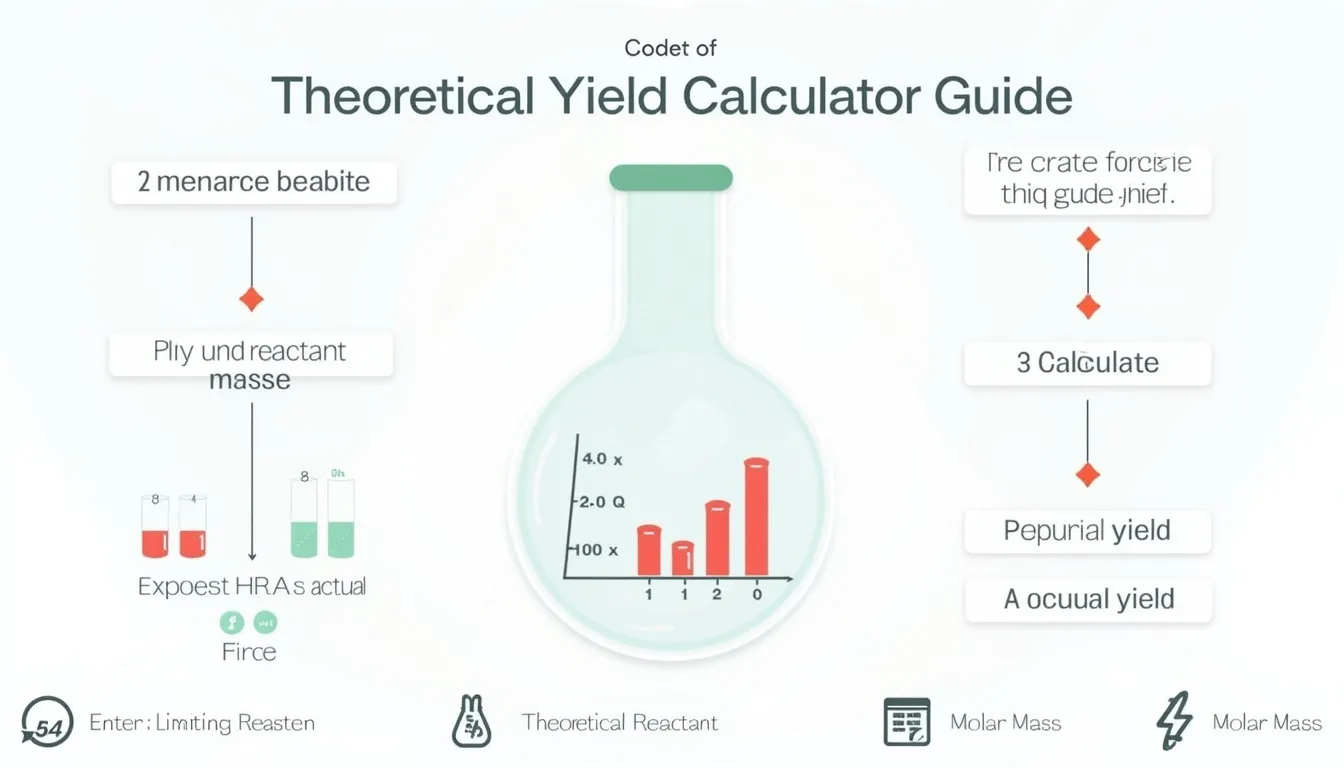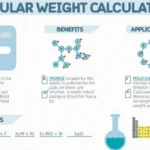Theoretical Yield Calculator
How to use the tool
- Type a balanced equation
Example 1: Fe2O3 + 3CO → 2Fe + 3CO2
Example 2: Mg + 2HCl → MgCl2 + H2 - Add reactant masses (g)
• Fe2O3: 5.00 g • CO: 4.00 g
• Mg: 2.00 g • HCl: 10.0 g - Press “Calculate Theoretical Yield” to see:
• Limiting reactant
• Molar masses (g/mol)
• Moles of each species
• Theoretical yield of the first-listed product
Core formulas
- Moles: $$n = rac{m}{M}$$
- Limiting ratio for reactant i: $$R_i = rac{n_i}{\nu_i}$$
- Yield of product j: $$m_j = n_{\text{lim}}\times \nu_j \times M_j$$
Worked example (Mg + 2HCl)
- Molar masses: Mg 24.305, HCl 36.461, MgCl2 95.211 g/mol (NIST WebBook, 2023).
- Moles: Mg $$= rac{2.00}{24.305}=0.0823$$ mol; HCl $$= rac{10.0}{36.461}=0.274$$ mol.
- Ratios: Mg 0.0823, HCl 0.137 ⇒ Mg limiting.
- Product moles: 0.0823 mol MgCl2.
- Theoretical yield: $$0.0823 \times 95.211 = 7.84\text{ g}$$.
Quick-Facts
- Atomic masses follow IUPAC 2023 standard values (IUPAC Red Book, 2023).
- Limiting-reactant logic mirrors textbook stoichiometry (Masterton & Hurley, Chemistry 12e, 2022).
- Up to 10 reactants accepted per run (Tool documentation, theoreticalyieldcalculator.com).
- Outputs rounded to 4 decimal places for precision (ISO 80000-1, 2019).
- Free web tool; no login required (Tool homepage, theoreticalyieldcalculator.com).
FAQ
What is theoretical yield?
Theoretical yield is the maximum mass of product predicted from balanced-equation stoichiometry when every reactant is fully consumed (Petrucci et al., General Chemistry 11e, 2020).
How does the calculator detect the limiting reactant?
It divides each reactant’s moles by its coefficient; the smallest result identifies the limiting species (Zumdahl, Chemical Principles 9e, 2023).
Can it handle hydrates or parentheses in formulas?
Yes. The parser reads common notations such as CuSO4·5H2O or (NH4)2CO3 (Tool documentation, theoreticalyieldcalculator.com).
Does temperature affect theoretical yield?
No. Theoretical yield assumes ideal conditions; temperature influences actual yield, not the stoichiometric maximum (Brown & Foote, Organic Chemistry 8e, 2021).
How do I use gas volumes?
Convert volume to mass via the ideal-gas law, then enter mass. At 298 K and 1 atm, 24.46 L of O2 equals 31.998 g (CRC Handbook, 2022).
Can I apply the tool to biochemical pathways?
Yes, provided each step has a balanced equation; many enzymatic reactions follow elemental balance rules (Berg et al., Biochemistry 9e, 2019).
How accurate are the atomic masses used?
Values come from the 2023 IUPAC evaluated data with uncertainties under 0.0001 u (IUPAC Red Book, 2023).
How do I calculate percent yield afterward?
Measure the product’s actual mass, apply $$\text{Percent Yield}= rac{\text{Actual}}{\text{Theoretical}}\times100\%$$, and compare efficiency (ACS Lab Protocols, 2021).
Is this tool helpful?
Important Disclaimer
The calculations, results, and content provided by our tools are not guaranteed to be accurate, complete, or reliable. Users are responsible for verifying and interpreting the results. Our content and tools may contain errors, biases, or inconsistencies. Do not enter personal data, sensitive information, or personally identifiable information in our web forms or tools. Such data entry violates our terms of service and may result in unauthorized disclosure to third parties. We reserve the right to save inputs and outputs from our tools for the purposes of error debugging, bias identification, and performance improvement. External companies providing AI models used in our tools may also save and process data in accordance with their own policies. By using our tools, you consent to this data collection and processing. We reserve the right to limit the usage of our tools based on current usability factors.







